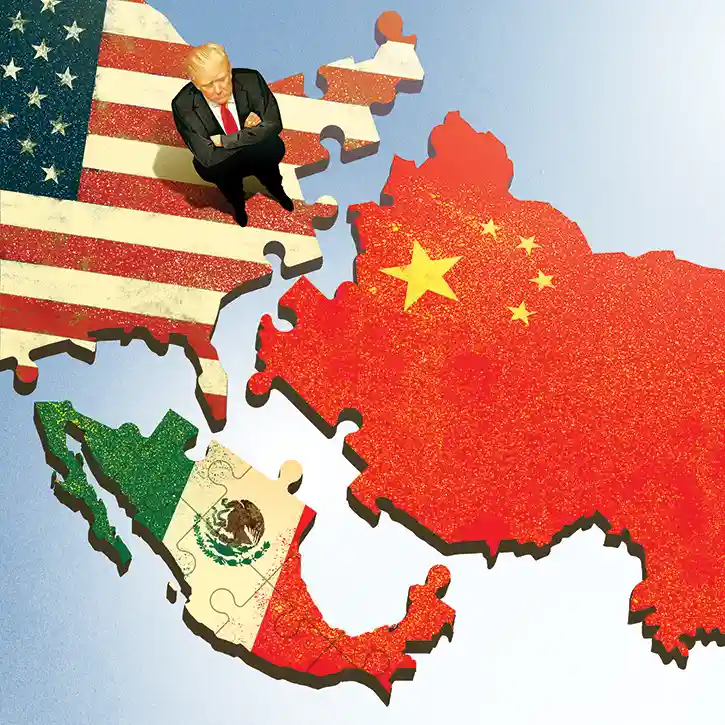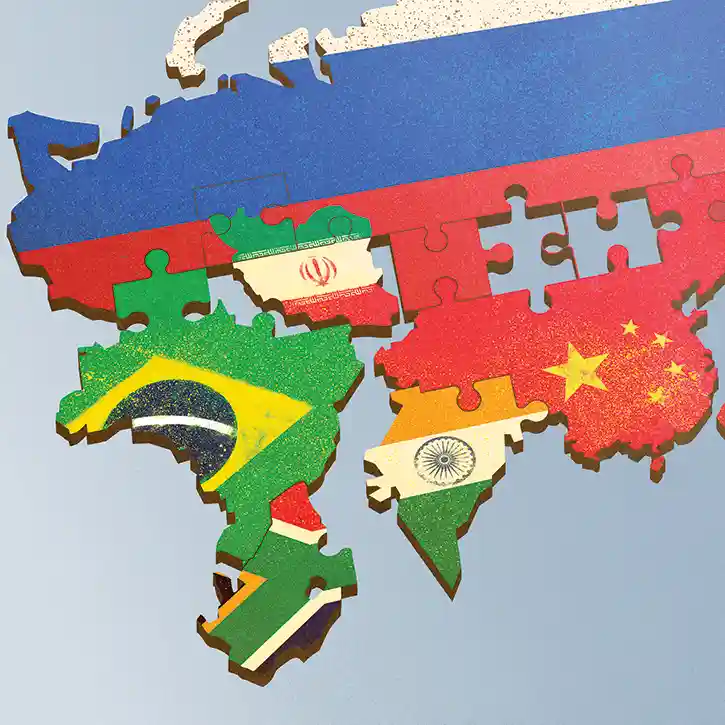On the bicentennial of the relationship between Mexico and the United States, I wrote in these pages about a new stage that, we could say, began with the arrival of Donald Trump to the presidency in 2017 and of Morena in 2018.
I warned then of three things. First, that the most important risk to the bilateral relationship was a misunderstood nationalism –especially in the economic sphere– whether by the United States or Mexico. Second, that the review of the United States–Mexico–Canada Agreement (T-MEC) scheduled for 2025-26 had to be very careful, as it would be a process contaminated by non-trade issues and, in a way, hijacked by the extremely high political polarization prevailing in our northern neighbor. Third, that we were facing a new and uncertain geopolitical scenario, with Cold War and clash of civilizations overtones –to paraphrase Samuel Huntington–, marked by “de-globalization” or “fragmented globalization”; the growing strategic competition between China and the United States; the Russian invasion of Ukraine, which exacerbates tensions in Eurasia and among NATO member states, and with a Latin America without a common project and quite divided.
The unusual arrival of Donald Trump to the presidency for the second time –after four years of Democratic rule under the leadership of Joseph Biden–, as well as the first weeks of his new administration give at least some weight to those warnings.
In a couple of months, Trump has confirmed that he maintains essentially the same ideology that we observed during his first administration, that he has decided to surround himself with collaborators faithful to that ideology and that he arrives with a better knowledge and method due to his previous experience. In a short period of time, Trump burst once again into U.S. domestic and foreign policy and again shook the bilateral relationship with Mexico in its three main axes: trade, security and migration.

We face anew with media diplomacy, often loaded with harsh pronouncements; the use and threat of tariffs on our products; and strong pressures in security and the fight against drug trafficking. Those pressures go as far as asserting that “drug trafficking organizations have an intolerable alliance with the government of Mexico” and that the Mexican government “has granted them safe haven to manufacture and transport narcotics”. Such a claim by the White House is unprecedented.
Considerable volatility and uncertainty will continue in the bilateral relationship for the remainder of this year and perhaps much of the next. By July 2026, the T-MEC review process is expected to be formally concluded, and the U.S. mid-term elections will be upon us. As I have noted before, I think that between now and that time, a review of the trade agreement is likely to be concluded with some aspects renegotiated.
I also believe that cooperation in security and law enforcement will take a qualitative leap forward, which is necessary and in Mexico’s own interest. Tensions over the migratory phenomena are beginning to ease: the number of encounters with migrants at the common border has decreased considerably. The so-called “invasion”, to which President Trump refers, is much smaller due to the actions of his administration and those carried out during the Biden presidency. In other words: the bilateral relationship will stabilize and there will be a new equilibrium with the Trump government in the next twelve to eighteen months. At the end of the day, despite their enormous power, it is difficult for presidents to completely change the direction of a ship as large as the United States.
Regardless of what may happen in the immediate future, it is necessary to reflect on the trajectory of the relationship between Mexico and the United States in the long term and in the new geopolitical context. On the one hand, the United States is transforming the way it intends to project its power and global leadership and, therefore, its foreign policy. It does not seem an exaggeration to assume that the world order gradually forged under U.S. leadership since the end of World War II is also being transformed. We are also going through important changes in the preferences and priorities of the U.S. voter and in the parties that move the chessboard of U.S. domestic politics.
On the other hand, in Mexico we are also in the early years of what appears to be a new regime, which conceives its role in the world differently from the one that prevailed in the last three or four decades.
The idea of North America as a primarily economic region, with a free trade agreement as its backbone and minimal geopolitical alignment, is very recent. It emerged in the last decade of the twentieth century and has so far shown considerable resilience, allowing it to withstand major shocks such as the terrorist attacks on the United States in September 2001 and their aftermath; the first Trump administration; the renegotiation of NAFTA towards the T-MEC; and the covid pandemic.
In my opinion, the North American project has been, to a certain extent, successful for the United States, Mexico and Canada, despite its natural problems and shortcomings. However, it must be noted that it was born in an almost unipolar moment, when globalization and, above all, trade liberalization were the basis for building and maintaining the world order.
These conditions have changed, and it seems necessary to think more carefully about the future of North America. The diplomatic motto that geography is destiny is well known. From this point of view, the three countries, linked by extensive land borders, with economies and societies that are now widely interconnected, and separated from Europe and Asia by two great oceans, have crossed a line that dictates that they continue to build a functional and hopefully even more beneficial relationship.
In the case of our country, the importance of this relationship is even clearer because of the way it has influenced our development model. Even today, when it is common to hear about Mexico’s Fourth Transformation, it is no exaggeration to say –as the writer Nicolás Medina Mora has intelligently done– that it is the product of the North American Free Trade Agreement and not of the ideas and actions of the last two Morena governments.
We are, however, at a time when the future of North America is uncertain, but never in the last forty years have the advantages of its deepening been so clear. The opportunity exists if trade and global value chains become regionalized and if the United States enters a stage where it seeks not only commercial but strategic partners that are more aligned in geopolitical and security terms. It appears that we have reached a turning point in the life of the North American project: either it deepens, or it dies.
I am inclined to think that our country should promote this deepening in two main areas: retaking the idea of a security perimeter between the three countries (with a careful analysis of the advantages, disadvantages and scope) and expanding labor mobility mechanisms in the region.

Today it is commonplace to state that Mexico’s foreign policy seeks to maintain good and respectful relations with all countries and, at the same time, to strengthen economic ties. The objective is so general that it is unquestionable. It has always been advisable to have a certain degree of diversification in our economic and political relations. The relevant question is how to achieve this in an intelligent manner and in a complex geopolitical context such as the current one.
First, Mexico has a network of fourteen free trade agreements with 52 countries, thirty agreements for the promotion and reciprocal protection of investments with 31 countries or regions, and nine economic complementation agreements and partial scope agreements within the framework of the Latin American Integration Association (ALADI). In other words, specific and important actions have been taken to diversify our economic relations. However, we also know that today we are the main trading partner of the United States, which means that around 80 % of our exports are destined to that country and that half of the foreign investment we receive comes from that country.
The latter invites us to think that the weight of economic geography is mostly unavoidable, but above all that diversification requires a long-term, systematic strategy that we do not resort to only when there is uncertainty regarding our trade relationship with North America. In this sense, it is advisable to review more objectively the decision to close ProMéxico and the real capacity of our diplomatic representations to successfully fulfill their tasks.
On another level: for many analysts, the most determining factor in international relations during this century is the strategic rivalry between China and the United States. It is sometimes suggested that this is a new Cold War and, therefore, Mexico could handle it as it did during a good part of the last century. The notion does not seem far-fetched, but it should be considered that in the face of the rivalry between the Soviet Union and the United States, the main concern of the latter –and of much of the world– was the nuclear threat and a conventional military conflict in Europe, and only to a lesser degree in proxy wars in various regions. The current rivalry between China and the United States is much more complex, as it encompasses the commercial, technological, political, cybernetic-information and military spheres, with the future of Taiwan standing out in relation to the latter.
In another issue, the efforts of powers that rival the United States and middle powers to build a new multipolarity have been reflected in the increase of mechanisms for dialogue and cooperation with very diverse objectives and scope. Such is the case of the mechanism initially formed by Brazil, Russia, India, China and South Africa (BRICS), which has now expanded to include ten countries, or the Community of Latin American and Caribbean States (CELAC).
It would seem a natural step that, in the context of a new multipolarity, some would recommend Mexico to participate or leverage its participation in these mechanisms. However, if this is the case, we should first analyze what such a decision could bring us. It cannot be ignored that these mechanisms are unlikely to have a concrete future due to the divergence of interests among their members. On the contrary, their present and future are confined to limiting the presence of the United States on the world stage.
In the Mexico-U.S. relationship, the role of individual presidents and governments has always been key. Efforts to institutionalize the relationship over the decades have also been essential: the set of agreements, dialogue mechanisms and organizations created to manage and give stability to the relationship. Similarly, what their societies perceive about this relationship influences the decisions of presidents and their governments.
It is often argued that the relationship between the two countries is intermestic. To the extent that it transcends foreign policy and the population on both sides of the border assumes it as a domestic or internal political issue. This phenomenon seems to be more relevant to the extent that the bilateral relationship occupies media spaces and that the actors who conduct it resort to media diplomacy. Despite this, we have little information and little analysis of what Mexicans and Americans think and want from the relationship between their countries.
We can assume that Mexico is well known in the United States. For example, the YouGov survey (2024) ranks us 29th out of 195 countries, with 96 % name recognition and 52 % positive views. The same survey suggests that 55 % of U.S. voters see Mexico as an ally, compared to 29 % who see it as an enemy. By political party, we find that 47 % of Republican voters consider us an enemy versus only 14 % of Democrats. Gallup has similar survey data since 2001 but has not sufficiently analyzed the factors that explain the variations over time.
It seems to me that we also have a limited vision of the perceptions and priorities that Mexicans have regarding the relationship with the United States, beyond some data provided by the Americas and the World survey promoted by the CIDE at the time, which for 2021 showed a favorable opinion of Mexicans towards the United States (66 %). The World Values Survey, which has been conducted since 1981, provides a great deal of information on the values of Mexicans and Americans, but it seems to me that it has been little analyzed in the specific context of the bilateral relationship. Regarding trade, thanks to some surveys we know that shortly after the signing of the T-MEC (May 2019), it enjoyed strong approval (around 80 %) in both countries. However, to my knowledge, that has not been measured consistently over these years.
The need to know more about what Americans think of the Hispanic population is more than evident. Hispanics in the United States –about 60 % of whom are of Mexican origin– undoubtedly represent a group of growing economic, political and cultural importance. The U.S. Census Bureau estimates that the Hispanic population could reach nearly 70 million by 2025 and 100 million by 2050. The Mexican government has always sought to leverage this community in its relationship with the United States, but doing so successfully requires a better understanding of the particularities of this community, its vision of Mexico and its sense of belonging to the United States.
The relationship between Mexico and the United States is going through a particularly complex moment. The focus is now on how to successfully navigate a new multidimensional negotiation with Donald Trump’s second administration. We are going through unprecedented tensions between economic interdependence on the one hand, and political differences and sovereignties on the other. I believe that this negotiation will conclude on somewhat satisfactory terms, with new agreements and balances on trade, security and migration. However, we cannot lose sight of two key premises for the medium and long term. First, Trump is the consequence of profound changes in US politics and society. These changes will prevail beyond his term in office. Second, the United States is rethinking its relations with the world and its role in it. In today’s geopolitics, several countries and blocs are envisioning and promoting the end of the Pax Americana and the construction of a new world order that to this day raises more questions than it answers. The possibility of building a good relationship in the future depends on a good reading of these changes and knowing how to manage them. The cost of not doing so would have serious consequences on the relationship that most impacts the daily lives of a good part of Mexicans.
Gerónimo Gutiérrez Fernández.
Mexico’s ambassador to the United States (2017-2018), managing director of the North American Development Bank (2010-2016) and deputy secretary for North America (2003-2006).





